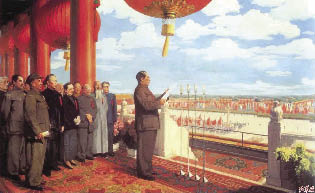|
The generation of painters after them keenly felt that Chinese painting was gradually waning, so they set about transforming it utilizing Western techniques. Xu Beihong, for example, devoted his whole life to rebuilding Chinese painting using realism, and made outstanding contributions to oil painting, as well as the teaching of oil painting techniques.
Xu Beihong traveled to France in 1919 to study, and then went to Germany and Belgium to study and research drawing, oil painting and the history of Western art. He returned to China in 1927 and held a number of academic posts, including dean of the Art Department of Shanghai South China Art Academy, art professor at National Central University in Nanjing, dean of the Art School of Peiping University, and head of Peiping Art College. After 1949, he was appointed the first chairman of the Chinese Artists' Association and president of the Central Academy of Fine Arts. He insisted on injecting realism into Chinese painting and created a series of works on historical themes, such as Tianheng Five Hundred Soldiers and Sound of the Vertical Bamboo Flute. These works mainly praised national integrity or depicted the masses' desire for wise leadership. Most of his oil works are based on Chinese history, but their expression is purely French in style. It took Xu Beihong's innovations to move Chinese oil painting into a new stage of development.
Oil Painting with a Chinese Flavor
After the founding of the People's Republic of China in 1949, oil painting was stressed as it was ideal for depicting realistic subjects on a large scale. Many artists of the period shared Xu Beihong's belief in realism. Realistic techniques and romantic representations of heroic figures and grand historical scenes were common.
 |
| Founding Ceremony of the PRC by Dong Xiwen. |
The new Chinese government selected young painters to study in the Soviet Union, and soon after invited K.M. Makchmob (1913-1993), a Soviet oil painter, to teach an advanced oil painting class in China. Graduates of this class soon became the backbone of Chinese oil painting. Revolutionary realistic oils of the USSR exerted a far-reaching influence on Chinese oil painting at the time, spurring the creation of a large number of oil paintings depicting Chinese people's resistance to the Japanese invasion, and later, construction of New China. Luo Gongliu's Tunnel Warfare and Zhan Jianjun's Five Heroes on Langya Mountain are representative of this period.
Through studying abroad and tutored by foreign experts, Chinese artists became fully conversant with oil painting techniques. The next task for painters was rebuilding the social function of Chinese oils. Many young painters went to southwestern and northwestern China to collect folk materials and find inspiration, in a quest to blend Chinese traditional elements with Western oil painting. It was the consensus of these artists that their works must satisfy Chinese aesthetic judgments, such as a general preference for simple and bright original color instead of changeable compound colors, and for straightforward presentation of the main characters without using too much light and shadow on their faces.
Dong Xiwen (1914-1973) was one of the best of these vigorous painters. His Founding Ceremony of the PRC was a milestone in Chinese oil painting, boldly incorporating national styles. He adopted techniques used in Chinese landscape painting to erase a red column to the right of Chairman Mao. In addition, he employed perspective to conjoin the masses under Tian'anmen with the leaders in the foreground on the rostrum, forming a contrast between the far and the near. In his use of colors, he utilized traditional Chinese vermilion in large areas of columns, lanterns and carpet, setting the tone of the painting. The work played up a happy atmosphere with colored banners and flags, blooming flowers, azure skies and white clouds. Judged by European oil painting standards, the use of colors was too intense and saturated. However, the oil won high praise from Xu Beihong and many other senior painters, who believed the painting opened a new chapter in the development of Chinese oil painting.
During the "cultural revolution" (1966-1976), Chinese oil painting emphasized a "red, bright and shinning" effect, and relied heavily on vermilion and bold colors. A "lofty, imposing and straightforward" figure painting style was pursued in the depiction of heroes. There emerged some exemplary applications of the style. The best known is Liu Chunhua's Chairman Mao Goes to Anyuan (1967), which was a great hit around the country and soon became a "model work." It was sold for RMB 6.05 million by China Guardian Auctions Company in 1995, setting a record in Chinese oil painting auction history.
|
